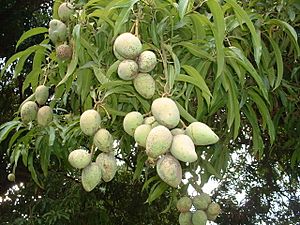Haribhanga (mango) facts for kids
Quick facts for kids Mangifera 'Haribhanga' |
|
|---|---|

Unripe mangoes on a mango tree
|
|
| Genus | Mangifera |
| Cultivar | 'Haribhanga' |
| Marketing names | 'Haribhanga' |
| Origin | Bangladesh |
The Haribhanga mango is a special kind of mango grown in the northwest part of Bangladesh. It's especially popular in the Rangpur area. Farmers in northern Bangladesh have started growing more and more of these delicious mangoes.
Haribhanga mangoes are round and have a lot of juicy flesh inside. They usually weigh between 200 and 400 grams. Some have even been found weighing up to 700 grams! In July 2021, India received 2600 kilograms of Haribhanga mangoes from Bangladesh. This gift showed the strong friendship between the two countries.
History of the Haribhanga Mango
The Haribhanga mango became widely known around the year 2003. A person named Abdus Salam Sarkar helped make it popular. Today, many Haribhanga mangoes are grown in places like Mithapukur, Badarganj, Pirganj, and Sadar upazilas in the Rangpur district. The Department of Agriculture Extension (DAE) is also working to help grow even more of these mangoes.
How Haribhanga Mangoes Help the Economy
Growing and selling Haribhanga mangoes is very important for many people in the Rangpur district. About 30,000 people in Mithapukur and other areas depend on this mango for their living. Traders from big cities like Dhaka, Rajshahi, and Chittagong come to local markets to buy Haribhanga mangoes.
During mango season, these mangoes are sold in large amounts. They can sell for about Tk 1800–2000 per maund. This is about $0.27–0.30 for every pound of mangoes. This trade helps many families earn money and supports the local economy.

